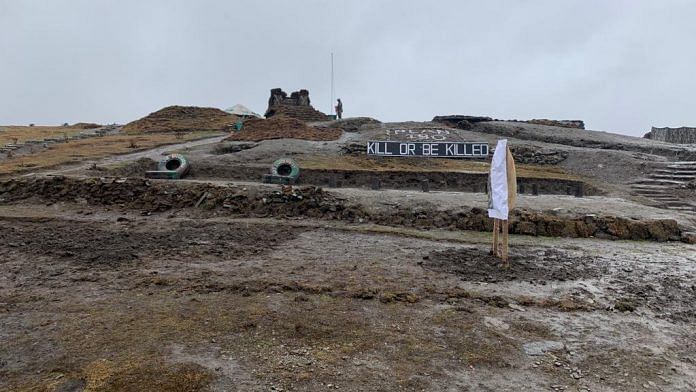The recent clash between the soldiers of India and China in Yangtse in Arunachal Pradesh’s Tawang sector brought back the memories of the 2020 Galwan Valley clash, which had led to the death of 20 Indian soldiers.
While incursion attempts happen almost every year, what’s unique now is the increasing number of PLA soldiers engaged in them. On the morning of 9 December, over 200 PLA soldiers armed with monkey fists, taser guns and spiked clubs with nails fitted on them tried to cross over the Line of Actual Control (LAC) in Yangtse, which is one of the mutually recognised disputed areas.
Incidentally, the Indian Army had occupied Yangtse in 1987 in response to the Chinese intrusion in Sumdorong Chu.
Sources in the defence establishment said that Yangtse fell within India’s claim lines but was never occupied until 1987. It is only when the Chinese invaded Sumdorong Chu that the Indian Army decided to occupy Yangtse, much to the discomfort of the PLA. The Sumdorong Chu intrusion led to a protracted military confrontation, which was only resolved after diplomatic negotiations in the mid-1990s.
The recent clash has brought back focus on the disputed area, which is why Yangtse in Tawang sector is ThePrint’s Newsmaker of the Week.
Also read: Tawang skirmish shows LAC’s volatile. Army risking getting mired in Siachen-style resource trap
China aims to change status quo
Defence Minister Rajnath Singh told Parliament that the PLA had attempted to enter Yangtse “to unilaterally change the status quo”.
Sources said that the Chinese were very peeved in 2020 when Arunachal Pradesh Chief Minister Pema Khandu inaugurated a gompa under the Chumi Gyatse waterfalls, just about 250 metres from the LAC.
Since 2020, the Arunachal Pradesh government and the Indian Army have been developing the area around the waterfalls, which is highly revered by the Tibetan Buddhists or Monpas on both sides of the border, and is a popular tourist site. Monpa is one of Arunachal’s major tribes, with its population scattered in Tawang and West Kameng districts.
India has also constructed a road up to the remote Tsechu village near the LAC, where the Chumi Gyatse falls from a height of 11,000 feet.
The Chinese had placed a surveillance camera, a projector and a large screen at the LAC overlooking the falls to get live images.
One big disadvantage for the Chinese in this area is that the Indian Army occupies all the heights, including the post at about 17,000 ft, which gives a full view of the Chinese positions.
Sources said that Chinese movement can be visible for 30 minutes every time they move towards the Indian posts.
The Chinese assessment was that the Indian post that they attacked had only about 40-50 personnel and it would be easy to overwhelm them. However, much to their surprise, the small group of Indian soldiers stood their ground and formed a human chain to stop the Chinese ingress.
This resulted in a lot of pushing and shoving before India’s planned second layer of defence came in.
Seeing the larger number of Indian soldiers coming in with war cries within less than half an hour, the surprised Chinese troops, according to sources, started pelting Indian soldiers with stones. The fight turned into a street-brawl kind of clash in which two nuclear armed countries battled it out with crude hand-held weapons.
Explaining the chain of events, sources said that the Indian troops are less in numbers close to the LAC. These units are basically meant for patrolling and form part of the quick reaction team to match the Chinese strength in forward areas if the need arises.
However, the Indian Army has a second layer of troops now, closer to the LAC, as part of the new deployment plans that were introduced since tensions first erupted in eastern Ladakh in 2020.
Also read: Did PLA force Galwan captives to make ‘confessions’? Footage surfaces in India-China video war
Yangtse, China’s sore point
While over two dozen Indian soldiers suffered injuries including broken bones, sources said that the Chinese suffered more as some of them were medically helped by Indian Army troops.
While the Yangtse clash is another reminder of how tense the LAC is, top sources in the defence establishment said that they see this as a stand-alone incident and not part of a larger Chinese strategy. They said Yangtse remains a sore point for the Chinese and this incursion attempt happens every year, usually in September-October.
Just like the clash on 9 December, there was an incident in October last year at the same location which also saw injuries, more on the Chinese side.
A video of last year’s clash began circulating on Indian social media with claims that it was from 9 December. Incidentally, both incidents involved the same Battalion of the Indian Army.
Both India and China have carried out large scale deployment of troops and equipment along the LAC as tensions rose in May 2020 with the PLA troops attempting to change the status quo in eastern Ladakh.
ThePrint had earlier reported that India is ramping up its infrastructure in Arunachal Pradesh to counter an aggressive China. This included speeding up work on new tunnels that provide all-weather connectivity to critical border areas and building new road access, bridges, forward helicopter bases and underground fortified ammunition storage.
After seven decades of dithering on establishing border connectivity in the Northeast, India has initiated a massive infrastructure building, the showpiece of which is the Arunachal Frontier Highway that will run through the McMahon Line.
Views are personal.
(Edited by Prashant)



